Content marketing is all about creating and sharing valuable content to attract and keep customers. It focuses on building relationships through meaningful engagement rather than just selling.
This approach helps businesses connect with their audience by solving problems, answering questions, and providing value.
Today, people are bombarded with ads and promotions everywhere. That’s why content that genuinely helps or entertains stands out. This type of marketing builds trust and turns casual readers into loyal customers over time.
Introduction to content marketing

So, what even is content marketing?
It’s like planting seeds in a garden—nurturing, watering, and giving them some sunshine until they bloom. In content marketing, the seeds are words, images, and stories.
It’s the art of storytelling with a dash of strategy—creating content that doesn’t just talk, but connects, informs, and even inspires.
But why bother, right? Why invest time in creating content when you could be doing a dozen other things?
Because people are tuning out the typical sales pitch. They want realness, value, and a genuine connection. That’s where content marketing waltzes in.
It builds bridges, not barriers.
It’s not just about filling up a blog with words or shooting off random social media posts.
It’s about creating meaningful content that resonates with your audience. The kind that makes them say, “Hey, these folks get me” or their current business challenges.
Because when they feel understood, trust follows. And in business, trust is golden.
Benefits of content marketing
You’ve heard the buzz, right? Content marketing is all the rage. But what’s the real juice here? Let’s break it down.
- Boosts brand awareness: Think of content marketing as your brand’s voice at the dinner table. The more engaging your stories, the more people want to hear them. It’s about getting noticed—without shouting.
- Fosters customer loyalty: Ever had a friend who always gives you great advice? That’s what great content does. It keeps your audience coming back for more.
- Drives organic traffic: Good content and search engines just fit together. When you provide high-quality, SEO-optimized content, Google takes notice. And when Google’s happy, more people find you without you paying for it.
- Increases engagement: Let’s face it, people want to be entertained, informed, or at least intrigued. Content that sparks interest or emotion can create a ripple effect. Likes, shares, comments—these aren’t just vanity metrics. They’re virtual high-fives from your audience.
- Generates leads and conversions: If your content is boring, users won’t return. But if it’s engaging, informative, and aligns with what your audience needs, they’ll want to know more. And more often than not, they’ll convert.
Successful content marketing is like the snowball effect. It will pick up speed and grow as you go. Content marketing is a long game, but one with huge payoffs if you are persistent and provides real value.
Why is content marketing important?
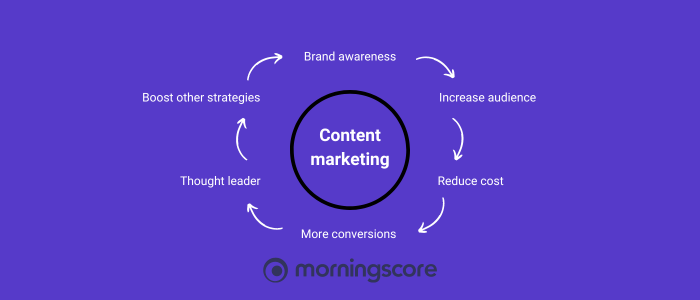
Content marketing is a big part of most digital strategies. As consumers are constantly bombarded with advertisements, content marketing offers a more subtle and effective way to reach and engage an audience.
At its core, content marketing focuses on providing value rather than pushing a hard sell. It’s about creating and distributing relevant, high-quality content that resonates with the target audience, addressing their needs, pain points, or interests.
The content marketing approach helps businesses build trust and credibility, which are crucial for long-term relationships with customers.
One of the key reasons content marketing is important is because it builds meaningful connections. Instead of being transactional, these connections are built on shared values, interests, and understanding.
When a brand consistently delivers valuable content, it positions itself as a thought leader in its industry, someone who understands their audience’s challenges and offers solutions.
This type of engagement is far more effective than traditional advertising because it speaks directly to the audience’s needs, making them feel understood and valued.
As a result, potential customers are more likely to trust the brand, consider its products or services, and remain loyal over time.
Content marketing helps in nurturing leads and guiding them through the buyer’s journey. Unlike one-off advertisements that often lack context or depth, well-made content provides layers of information that help potential customers make informed decisions.
For instance, educational articles, blog posts, videos, and e-books can address different stages of the decision-making process.

A blog post might create initial awareness, an in-depth guide might help in consideration, and a customer testimonial could be the deciding factor that pushes a lead toward a purchase.
By providing valuable information at each stage, content marketing places a brand top-of-mind and facilitates a smoother transition from potential to actual customers.
Content marketing also affects customer retention. When customers find valuable content that educates or entertains, they are more likely to share it within their networks, amplifying the brand’s reach organically. This not only brings in new customers but also creates a community around the brand.
Engaged customers are more likely to become advocates, promoting the brand and defending it against negative feedback. This kind of organic growth and customer loyalty is difficult to achieve through traditional marketing methods, making content marketing a critical strategy for modern businesses.
In addition, content marketing provides long-term value. Unlike paid ads that stop being effective the moment you stop spending money, well-made content has a lasting impact.
A high-quality blog post, video, or infographic can continue to attract traffic, generate leads, and drive conversions months or even years after it has been published. This makes content marketing a cost-effective strategy in the long run, offering a high return on investment.
Why is content marketing important for SEO?

Content marketing is undoubtedly linked to SEO, making it an essential strategy for improving a website’s visibility on search engines like Google.
When done correctly, content marketing can significantly boost SEO efforts by providing valuable and relevant content that search engines deem worthy of ranking. One of the primary reasons content marketing is important for SEO is because it allows you to target specific keywords and topics that your audience is searching for.
Search engines aim to provide the most relevant and useful information to their users. By creating content that answers questions, solves problems, or provides in-depth insights on topics related to your business, you increase the chances of ranking higher on search engine results pages.
High-quality content is the backbone of any effective SEO strategy. Search engines like Google use complex algorithms that analyze various factors, including content relevance, originality, and user engagement, to determine a page’s ranking.
When content is well-written, informative, and aligns with what users are searching for, it naturally performs better. Content marketing allows you to produce content that targets the specific queries and keywords that are most relevant to your audience.
Over time, this not only improves your site’s authority but also drives more organic traffic, which is crucial for sustained growth. We’ll look into a couple of examples later in this post where HubSpot have reached a point with millions of organic visitors straight from their Google rankings.
Another reason content marketing is important for SEO is that it leads to backlinks. High-quality, valuable content is more likely to be referenced and linked by other websites.
Backlinks are an important ranking factor for search engines because they signal that your content is credible and trustworthy.
The more high-quality backlinks you have, the more search engines view your site as an authoritative source, which can lead to higher rankings.
Content that is shareable and linkable, such as comprehensive guides, research studies, or unique insights, is an excellent tool for building valuable links.
Content marketing also improves on-page SEO elements. Effective content marketing strategies involve optimizing various on-page elements like meta descriptions, title tags, headers, and images, which play a significant role in SEO.
By incorporating relevant keywords naturally and optimizing these elements, you help search engines better understand the content of your page. This leads to improved indexing and ranking potential.
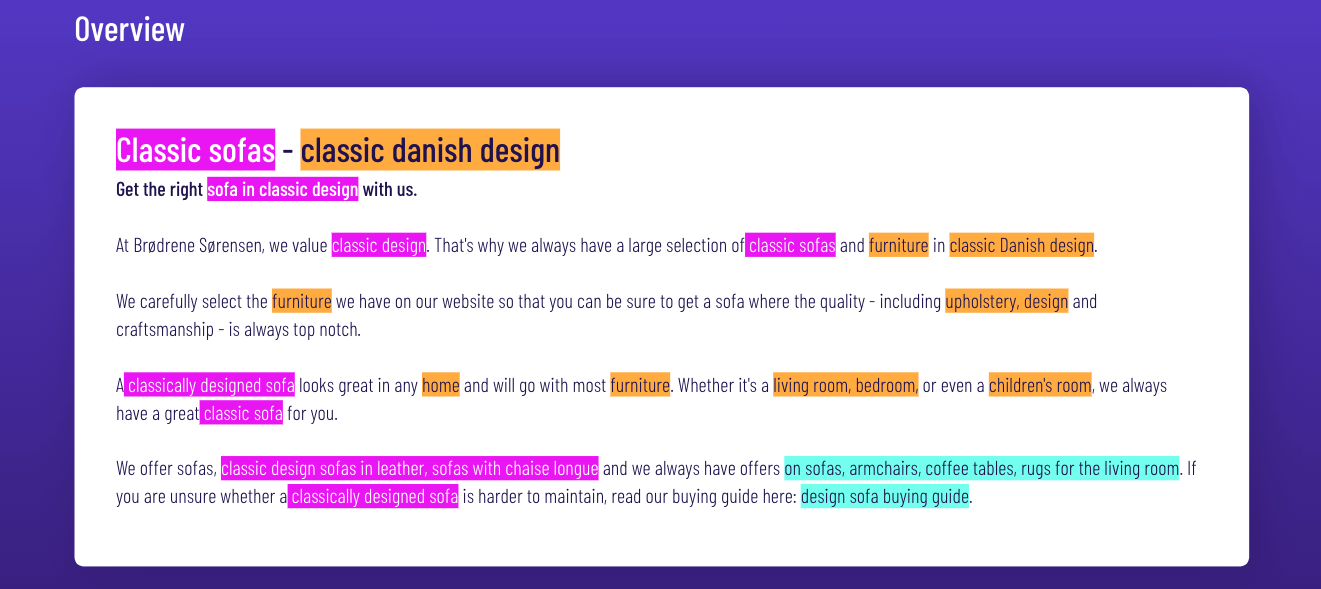
Additionally, content marketing boosts user engagement, which are increasingly important in SEO. Search engines consider how users interact with your content, including how long they stay on your page, the pages they visit next, and whether they return to the search results.
High-quality content that keeps users engaged for longer periods can positively impact these metrics, signaling to search engines that your content is valuable.
It’s important to run regular onpage audits to make sure that your website is delivering a smooth user experience.
More than half of all online content consumption comes from organic search
According to BrightEdge 51% of content consumption is from search engines. This statistic highlights the importance of search engines as a primary gateway for users seeking information, entertainment, or solutions on the internet.
Given that most people rely on search engines to discover content, it’s crucial for content creators and marketers to prioritize search engine optimization (SEO).
By doing so, they not only improve their content’s visibility but also cater to the natural search patterns of their audience, thereby boosting the chances of attracting and retaining engaged visitors.
Types of content marketing strategies
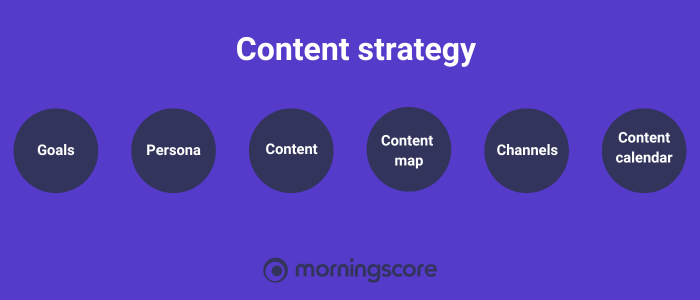
When it comes to content marketing strategies, there are various options to consider, each bringing its own strengths to the table.
The effectiveness of your content depends on choosing the right type that aligns with your goals and resonates with your audience. Some strategies focus on providing in-depth information and building authority, like blogging and creating e-books.
Others are geared toward fostering engagement and interaction, such as social media content or webinars. The key is to understand the unique benefits each strategy offers—whether it’s driving traffic, educating your audience, or generating leads—and to select the mix that best supports your overall marketing objectives.
Here’s where things get spicy. Content marketing isn’t a one-size-fits-all approach. There are many flavors to choose from, each with its own appeal.
- Blogging and article writing: The old faithful. Blogs aren’t just digital diaries. They’re educational libraries. A well-written blog post can position you as an expert, answer burning questions, or even entertain. This is your little corner of the internet where you get to showcase your expertise.
- Video content and webinars: If a picture says a thousand words, a video says a million. People love visuals—they’re engaging, memorable, and, let’s be honest, sometimes easier to digest. Webinars take it up a notch by offering interactive, value-packed sessions that feel like a mini-workshop. They’re great for building authority and trust.
- Social media content: Quick bites of content served with a side of personality. It’s not just about posting updates; it’s about starting conversations, joining in on trending topics, and creating shareable moments. Remember, social media is where your brand gets to loosen its tie a little.
- Email marketing and newsletters: Still one of the most powerful ways to speak directly to your audience. It’s your chance to get into their inboxes with curated content, special offers, or exclusive insights. But tread lightly—nobody likes spam.
- Infographics and visual content: Got data? Turn it into a story. Infographics simplify complex information, making it easy to digest and, more importantly, easy to share and might even be working as link magnet boosting your backlink profile and domain authority.
- Podcasts and audio content: On-the-go content for those who prefer to listen rather than read. Podcasts are popular, and they’re perfect for deep dives into topics, interviews, or just casual chats.
- E-books, white papers, and case studies: This is where you showcase your in-depth knowledge. Packed with valuable insights, they help convert readers into leads and leads into loyal customers.
There’s no single right way to do content marketing—just find what clicks with your audience and run with it.
To hit the jackpot you need to test, test and test. Find out what it is that your audience appreciates and wants to engage with.
Understanding the content marketing funnel

To effectively reach and convert potential customers, it is crucial to understand the content marketing funnel. This concept outlines the different stages a person goes through, from becoming aware of your brand to deciding to make a purchase.
At each stage, the needs and behaviors of the audience change, and your content should be designed to meet the requirements. The funnel is divided into three main stages: Awareness, where the goal is to attract and inform; Consideration, where the focus is on building trust and providing deeper insights; and Decision, where the content aims to support final purchasing decisions.
By aligning your content with these stages, you can create a more targeted and effective consumer marketing strategy or B2B marketing strategy that moves potential customers smoothly from one step to the next, ensuring that they feel informed, valued, and ready to choose your product or service.
So, let’s take a look at the content marketing funnel stages. Think of it as a journey—your customer journey from being strangers to becoming loyal customers. And every step needs the right kind of content.
- Awareness stage: Picture this. Someone’s wandering around, not quite knowing what they’re looking for, but they stumble upon your blog or video. Here, content should be broad, engaging, and, above all, helpful. Think blog posts, how-to guides, and educational videos. The customer might not even know that they need your product at this point.
- Consideration stage: Now they’ve crossed the street and are chatting with you. They’re interested but need a bit more convincing. This is where you bring out the big guns—comparisons, expert insights, and testimonials. Content like e-books, webinars, and case studies fit perfectly here.
- Decision stage: The moment of truth. They’re ready to make a decision but want to be absolutely sure. Here, content should provide that final nudge—demos, free trials, or detailed product guides. This is your final pitch, but without the pushiness.
Navigating these stages is about creating content that matches their mindset at each stage. No one wants to feel rushed into a decision, and great content respects that.
This funnel isn’t rigid. People move through it at their own pace. But with the right content, at the right time, you can gently guide them through.
Some users will also skip the consideration phase or at least just be in it for a couple of minutes in their mind just like they don’t necessarily interacts with your content from the awareness stage.
Sometimes, a simple Google search will result in an instant purchase without looking at any of your content.
Content marketing best practices
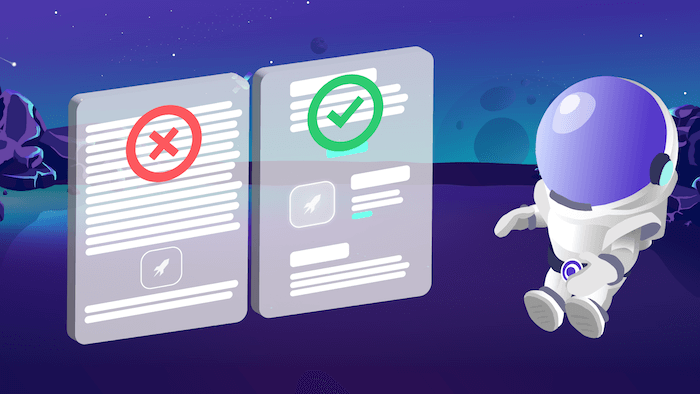
To excel in content marketing, it’s important to follow proven practices that ensure your efforts are both effective and sustainable.
Good content is not just about quantity; it is about creating meaningful and relevant material that engages your audience and meets their needs. This involves thorough keyword research to understand what your audience is searching for, creating content that offers real value, and maintaining a consistent publishing schedule to build trust and anticipation.
Additionally, optimizing your content for search engines without overloading it with keywords is essential for discoverability.
Monitoring performance through key metrics helps you understand what works and what doesn’t, allowing you to refine your approach. By incorporating user-generated content and leveraging the influence of trusted voices, you can build a more authentic and engaging brand presence.
These practices together form a comprehensive approach to content marketing that focuses on quality, relevance, and adaptability.
Content marketing isn’t just throwing words on a page and hoping they stick. It’s a blend of art and science. Here are some golden rules to live by.
- Do your homework (keyword research): The foundation of any great content strategy is knowing what your audience is searching for. Use tools like Morningscore to find the keywords that matter. But don’t just focus on the most popular ones; sometimes, the gold is in the niche, long-tail keywords.
- Create content that speaks (and listens): High-quality content isn’t about sounding smart. It’s about solving problems, answering questions, or simply bringing a smile. Keep it clear, engaging, and, above all, valuable.
- Be consistent, not predictable: Like a good TV show, people should look forward to your next piece of content. Consistency builds trust, but don’t be afraid to mix things up. A surprise now and then keeps things fresh.
- Optimize, don’t overdo: SEO isn’t about stuffing keywords. It’s about making your content easy to find, easy to read and easy to understand. Use headings, bullet points, and images to break up text. A sprinkle of strategically placed keywords, not a flood.
- Measure and adjust (use KPIs): How do you know if your content is working? You measure it. Use key performance indicators like traffic, engagement, and conversions. And if something isn’t working? Don’t panic. Pivot. Adapt. It’s all part of the process. Test, test and test, remember?
- Leverage user-generated content and influencers: Sometimes, your best content creators are your customers. Encourage reviews, shares, and shoutouts. Partner with influencers who align with your brand—people trust people more than they trust brands.
How to create a content marketing plan
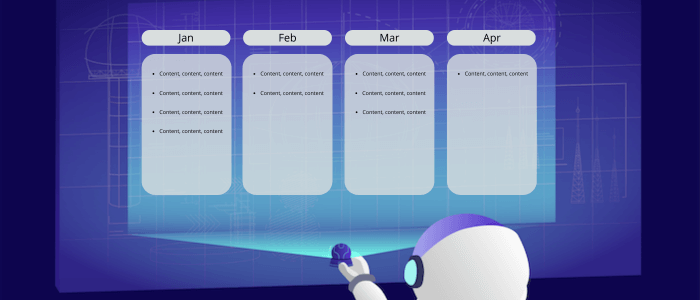
Building a content marketing plan is an important part that is often ignored. You wouldn’t start without knowing your destination on a trip, right? The same goes for content. You need a map or at least directions.
First off, define your goals. What are you trying to achieve? More traffic? Better engagement? Leads? You can’t hit a target you can’t see. Once you know what you want, you can create content that’s aligned with your goals.
Next, get to know your audience. Picture them. Who are they? What keeps them up at night? Understanding their needs is half the battle. Create detailed buyer personas. It’s not just a fluffy exercise; it’s the foundation of a strategy that works. You need to know who you are talking to.
Then, do a content audit. Look at what you’ve already got. What’s working? What’s not? This isn’t about critiquing every word—it’s about identifying gaps and opportunities. Sometimes, an old blog post just needs a little push to shine again.
And don’t forget to set up a content calendar. It’s your roadmap. It keeps you on track, ensures consistency, and helps avoid the dreaded content drought. Think of it as a safety net for your ideas.
Finally, remember that a plan is just the beginning. A good content marketing plan is flexible, adapting to feedback and changes in the audience’s needs. It’s less of a strict script and more like jazz—improvised, responsive, and engaging.
Tools for content marketing success
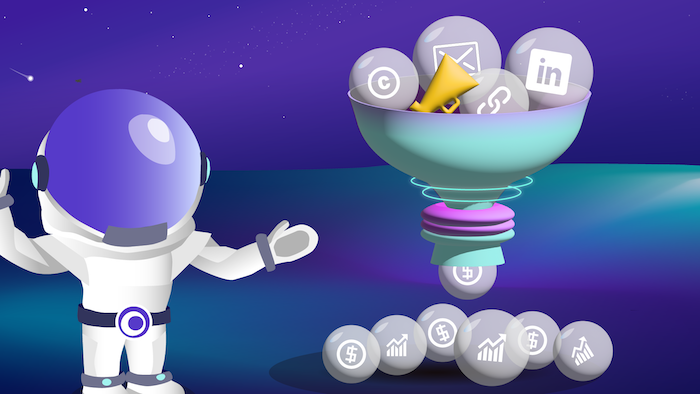
You wouldn’t fix a car without the right tools, and content marketing is no different. Let’s pop the hood and look at some tools to keep your content engine running smoothly.
- Keyword research tools: Tools like Morningscore, Ahrefs and Semrush are your metal detectors. They help you find the keywords your audience is searching for. No guesswork needed.
- Content Creation tools: Grammarly, ChatGPT, and Canva are like your trusty toolbox. Whether you need to polish your prose or spice up your graphic, these tools help you do it better and faster.
- Scheduling and distribution tools: Hootsuite and Buffer. They make sure your content gets where it needs to go, at the right time, without you lifting a finger.
- Analytics and reporting tools: Google Analytics, Search Console and Plausible are your navigators. They show you where you’ve been and help you figure out where to go next. What’s getting clicks? What’s falling flat? The data doesn’t lie.
Each tool has its own pro’s and con’s, but together they form a mighty arsenal to keep your content strategy not just on track, but thriving.
Challenges in content marketing and how to overcome them
- Generating fresh ideas: We’ve all been there—staring at a blank screen with no clue what to write next. Try brainstorming sessions, customer surveys, or even eavesdropping on social media conversations – or simply use one of the ChatGPT prompts for creating content and content ideas. Inspiration is everywhere if you know where to look.
- Maintaining consistent quality: Churning out content can feel like a hamster wheel. But it’s better to produce one great post a week than five mediocre ones. Focus on quality over quantity.
- Measuring ROI: Sometimes, proving the worth of your content feels like trying to catch smoke with your bare hands. Use specific metrics like conversion rates, changes in traffic, time on page, page visits and bounce rate. Track, adjust, repeat.
- Keeping up with trends: The online marketing game changes like the wind. And you need to stay informed. Follow industry leaders, subscribe to newsletters, and never stop learning.
Content marketing has its ups and downs, but with a bit of grit and creativity, you can turn challenges into stepping stones.
Keep in mind that the content creation isn’t enough by itself, because how do people find it?
This is where most businesses fails. They need the very last and absolutely critical part of content marketing: the distribution of the content.
Distributing your content

When it comes to distributing your content, choosing the right channels is very important for maximizing reach. The effectiveness of content distribution depends largely on understanding where your target audience spends their time and what type of content they prefer to consume on those platforms.
There is no one-size-fits-all approach; instead, it’s about aligning your distribution strategy with the preferences of your audience.
Start by evaluating your content and your goals. For example, if your content is highly visual, platforms like Instagram, Pinterest, or TikTok might be more suitable due to their focus on images and short videos.
For professional or B2B content, LinkedIn is often the go-to platform, as it caters to a professional audience that values industry insights and networking opportunities – but Facebook and the above mentioned visual-platforms is also potential distributing platforms for B2B companies.
Blog posts, white papers, and case studies may find their best audience on LinkedIn or through email.
Understanding your audience demographics can also guide your channel selection. Younger audiences may be more active on TikTok and Instagram, while older demographics might engage more on Facebook or through traditional email – or even physical mail.
You know, those paper ones in an envelope in mailboxes.
Knowing the age, interests, and behaviors of your target audience will help you decide where to focus your efforts. Social media analytics and insights from your website traffic can provide valuable clues about which platforms are driving the most engagement and conversions for your content.
Consistency across chosen channels is key. Posting regularly and interacting with your audience helps build a loyal following. However, it’s important not to spread yourself too thin.
Focusing on a few key platforms where your audience is most active is often more effective than trying to maintain a presence on every available channel. This approach makes your efforts concentrated and more impactful.
It’s also essential to tailor your content to fit the platform. A one-size-fits-all content piece is less likely to perform well across different channels.
Adjust your tone, format, and messaging to match the style of the platform while staying true to your brand voice.
For instance, a lengthy blog post may work well on your website or LinkedIn, but on Twitter, a concise summary with a link may be more effective.
Regularly reviewing the performance of your content on various channels is important. This will help you identify what’s working and where adjustments are needed.
Case studies: successful content marketing examples
HubSpot: Educating the market through inbound marketing
Background
HubSpot, a pioneer in inbound marketing, offers software products for marketing, sales, and customer service. From the beginning, HubSpot’s strategy has centered around providing value through education, establishing itself as a thought leader in the marketing industry.
Content marketing strategy
HubSpot’s content marketing strategy is about creating comprehensive, educational content that addresses the needs and pain points of its target audience—marketers, sales professionals, and business owners. Their strategy includes:
- Blogs: HubSpot’s blog is one of the most popular marketing resources with millions of monthly visitors, covering topics ranging from SEO and content creation to sales tactics and customer service. With high-quality, actionable content published consistently, they have successfully drawn organic traffic and established their authority to their main domain as well as their blog universe on its own subdomain.
- E-books and guides: They offer free, downloadable resources in exchange for contact information. These guides delve deeper into topics covered in their blogs, providing more value and capturing leads for further nurturing.
- Webinars and online courses: HubSpot offers webinars and free courses through their HubSpot Academy. These educational resources help professionals to educate themself further and often include certifications, increasing HubSpot’s reputation as an industry leader.
- Podcasts and video content: Their podcast series and video content, like “HubSpot Academy” and “The Growth Show,” focus on the latest trends, expert interviews, and in-depth discussions on marketing strategies.
Results
- Organic traffic: HubSpot’s commitment to consistent, valuable content has resulted in millions of monthly organic visitors to their website from around the world.
- Lead generation: The free resources and educational content funnel have helped HubSpot generate thousands of qualified leads every month.
- Brand authority: HubSpot is widely regarded as a thought leader in inbound marketing, with their educational content playing a key role in building this reputation.
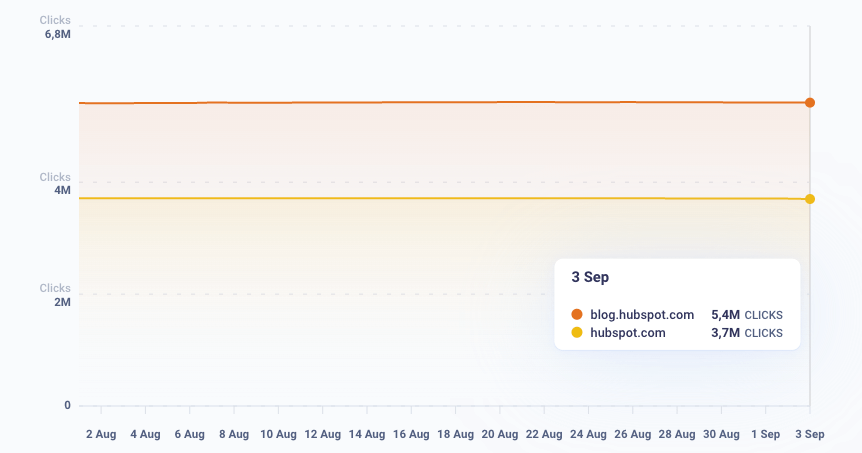
Key takeaway
By focusing on providing value through educational content, HubSpot has successfully established itself as a go-to resource in the marketing industry, driving both customer acquisition and brand loyalty.
LEGO: building a community through storytelling
Background
LEGO, the Danish toy company, is known for its colorful building blocks. The brand has a long history, but as digital play became more popular, LEGO needed a strategy to stay relevant and engage with a younger, tech-savvy audience.
Content marketing strategy
LEGO’s content marketing strategy is centered around storytelling, leveraging its vast universe of characters, settings, and creative possibilities:
- LEGO movies and TV shows: One of LEGO’s most successful content marketing efforts is its series of movies and TV shows, such as “The LEGO Movie” franchise. These movies not only entertain but also involves product placement, making LEGO sets desirable without obvious advertising.
- User-generated content and social media campaigns: LEGO encourages its “fans” to share their creations on social media, creating a sense of community and engagement. Campaigns like #RebuildTheWorld challenge users to think creatively and share their LEGO builds.
- LEGO ideas platform: LEGO Ideas is a co-creation platform where fans can submit their own designs for new sets. Popular designs are put to a vote, and winning submissions are turned into actual LEGO products. This not only drives engagement but also creates a steady flow of content and product innovation directly from the audience.
- Branded content and microsites: LEGO has created engaging microsites and online games for different audiences, such as LEGO Life and LEGO Kids. These platforms offer interactive content that keeps users engaged and creates brand loyalty.
Results
- Brand awareness: The LEGO Movies have grossed over $1 billion worldwide, significantly boosting brand awareness.
- Community engagement: The LEGO Ideas platform has led to the creation of numerous user-generated products, fostering a loyal fan community.
- Sales growth: LEGO’s innovative content marketing strategies have helped the company grow its sales even in the face of declining toy industry sales.
Key takeaway
LEGO’s success shows the power of storytelling and community-driven content. By creating content that entertains and engages, LEGO has been able to strengthen its brand and stay relevant across generations.
Future trends in content marketing
Content marketing isn’t static. It’s more like a river, always flowing, always changing course. So, what’s coming down the bend?
- AI and automation: Chatbots, automated content creation, and personalized recommendations—AI is making waves. It’s not science fiction; it’s here, and it’s making content creation smarter, not harder.
- Interactive content: People want to participate, not just consume. Think quizzes, polls, interactive infographics.
- Hyper-personalization: One-size-fits-all content? That’s yesterday’s news. Today, it’s all about content tailored to individual preferences. It’s about speaking directly to “you,” not “them.”
- Short-form video and stories: Quick, snackable content like TikTok videos and Instagram Stories are the frontier. They’re fast, fun, and fantastic for engagement.
FAQ on content marketing
What is content marketing?
Content marketing is a strategic approach focused on creating and distributing valuable, relevant, and consistent content to attract and engage a clearly defined audience. The goal is to drive profitable customer action by building trust and credibility rather than making direct sales pitches.
Why is content marketing important for businesses?
Content marketing helps businesses build brand awareness, establish authority, drive organic traffic, and nurture leads through valuable content. It creates a connection with the audience that can lead to increased loyalty and higher conversion rates over time.
How does content marketing improve SEO?
By creating content that answers questions, solves problems, and is loved by both readers and search engines. It’s a win-win.
What is evergreen content, and why is it valuable?
Evergreen content is content that remains relevant and valuable over time, such as how-to guides or industry best practices. It continues to attract traffic long after its publication, making it a valuable asset for sustained engagement and SEO.
What types of content work best?
It depends! Blogs, videos, podcasts—different strokes for different folks. Know your audience and cater to their tastes.
How can small businesses benefit from content marketing?
It levels the playing field. With smart strategy and a dash of creativity, even the smallest brand can stand tall.
What is the importance of content marketing in B2B versus B2C?
In B2B marketing, content often focuses on educating and providing in-depth industry insights to establish authority and trust. In B2C marketing, content tends to be more emotional and entertaining, aiming to connect with consumers on a personal level.
What are the key metrics to track?
Traffic, engagement, conversions—these are your bread and butter. Track what matters and adjust accordingly.
How often should content be published?
The frequency of content publication depends on the goals, resources, and audience preferences. Consistency is key, so it’s important to establish a realistic schedule. Some businesses publish daily, while others may publish weekly or bi-weekly.
What is the difference between content marketing and traditional advertising?
Unlike traditional advertising, which often pushes products directly to consumers, content marketing focuses on delivering valuable information that educates, entertains, or informs which is more of a pull strategy. The aim is to build trust and relationships over time rather than immediate sales.
Conclusion
Content marketing is more than just words on a page—it’s a conversation, a connection, a community.
Start with a plan, choose your tools, and embrace the process. Challenges will come, but with the right mindset, they’re just opportunities in disguise. And as trends change, keep your ear to the ground.

